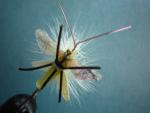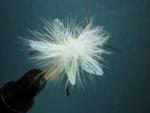Aero Fly a Perfect Spinner Fly
As we all know spinners or spent flies attract numerous trout to the surface. That’s why some of us are always looking for a spinner that will present a profile on the water unlike traditional spinner flies but just unique enough to make it stand out from the crowd. With this in mind I stared to experiment using different wing designs and body materials. What I ended up with is what I called the Aero Fly.
The Aero Fly does not have a traditional body and the wings form a fighter jet type of appearance thus the name. The body is 1/8 inch natural latex tubing although one can use a cream colored dubbing to achieve the same appearance. I used latex tubing for the color, the specific gravity of .94 to .95 and the fact that air can be trapped inside to ad to the buoyancy. It also has the advantage of not impeding the hook gap that a wrapped dubbing can sometimes do.
It is actually a fairly simple fly. The steps are as follows:
Hook – Size 8 to 16, 3 or 4x long with a light wire wrapped with Brown 6/0 thread
Legs – Brown rubber tied in on sides of the 1/3 down hook shank behind the eye
Antenna – Brown mono inserted in the 1/8 inch natural latex tubing (Max 10#)
Body – Natural latex shank length tied in tightly compressing it at leg tie in point
Wing – Iridescent web wing type material tied in at the same point
Wing Post – White Polypropylene
Wing Finish – White Saddle feather tied parachute style 5 to 8 wraps
Tail - Optional (Not Shown) two mono fibers
Finish with a drop of head cement or super glue at the eye and on the end of the latex tubing (if used) to seal in the air. This fly also works well by its self as a good imitator of a PMD




No comments:
Post a Comment